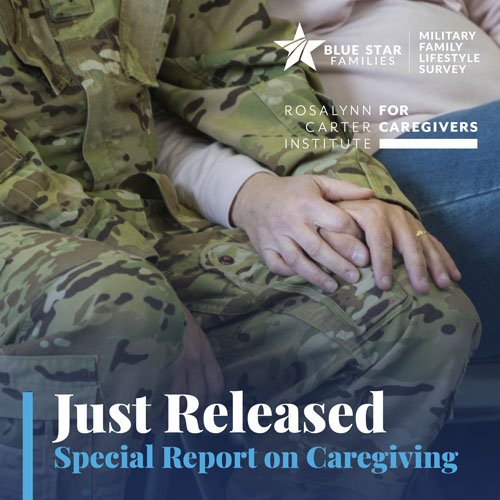2020 #BSFSURVEY Release
listen and learn
Did you miss part of the 2020 Military Family Lifestyle Survey results release event? Are you looking to catch up on the conversations? Press play on the videos below.
PANEL 1
The Impossible Choice: Housing, Schools & Financial Stability
PANEL 2
Impact on Women: Female Service Members & Military Spouses
PANEL 3
The Lived Experience of Diverse Families & Implications for Commands
PANEL 4
Military Children's Mental Health
What does the data say?
2020 Executive Summary
Learn about the main points of the 2020 survey by reading this brief overview of the findings.
2020 Comprehensive Infographic
Get quick references and stats on the issues that are most important to military and Veteran families.
2020 Comprehensive Report
Take an in-depth look at the 2020 results to learn how supporting military and Veteran families strengthens national security and local communities.
SPECIAL REPORT
Caregiving In Military Families
June 2021
Military families face unique challenges associated with military life. Caregivers shoulder the burdens of caring for loved ones.
Caregiving in Military Families, a special report created in collaboration with the Rosalynn Carter Institute for Caregivers, examines these two circumstances in combination: caregiving and military families. For the first time, you can get an unprecedented view of this special population through a focused exploration of data from the 2020 Military Family Lifestyle Survey. Learn how many military families are caregiving, who military caregivers are and who they are caring for, how the military lifestyle affects caregiving, and more.
2020 Survey Data
Overview
Since 2009, our annual Military Family Lifestyle Survey (aMFLS) has provided a comprehensive understanding of the experiences and challenges encountered by active-duty, National Guard, and Reserve service members, Veterans, and their families. It offers crucial insight to inform national leaders, local communities, and philanthropic actors. We conducted the 11th aMFLS from September to October 2020. Capturing experiences of nearly 11,000 respondents worldwide, and generating millions of data points, it remains the largest and most comprehensive survey of this community.
SUPPORTING MILITARY & VETERAN FAMILIES STRENGTHENS NATIONAL SECURITY & LOCAL COMMUNITIES
The tumultuous events of 2020 intensified some pre-existing concerns common across military-connected families, including spouse employment, child care, military children’s education, and time away. This year’s events underscored the importance of addressing these long-standing concerns, while shining a spotlight on systemic problems, clarifying issues, and sparking changes to give stakeholders interested in supporting military and Veteran families a clearer view of the path to recovery.
The 2020 Military Family Lifestyle Survey Comprehensive Report examines these shifts and opportunities through the social determinants of health, exploring the five pillars that set the conditions for individual and family health and well-being: community and social context, health care access, education access and quality, neighborhood and the built environment, and economic stability.1
Quick Links
Authors
A collaboration among the Applied Research team at Blue Star Families and the Institute for Veterans and Military Families (IVMF) at Syracuse University
BLUE STAR FAMILIES
Jessica D. Strong, Ph.D., Co-Director of Applied Research
Jennifer L. Akin, M.P.A., Co-Director of Applied Research
Kim D. Hunt, Ph.D., Senior Research Manager
Drew S. Brazer, Manager of Government Relations
Kathleen Farace, Social Impact and Outreach Fellow
CONSULTANTS
Karly Howell, M.A., Applied Research Generalist Consultant
Carrie Carter, Applied Research Generalist Consultant
IVMF
Rosalinda V. Maury, M.S., Director of Applied Research and Analytics
Rachel K. Linsner, M.S., Doctoral Research Fellow
Jeanette Yih Harvie, Ph.D., Research Associate
Community and Social Context
Discrimination in the Military: Service members report experiencing racial and gender discrimination, potentially impacting readiness and retention. Most did not report the most recent incident of discrimination. Also, a smaller proportion of those active-duty service member respondents who experienced military-connected racial discrimination (43%) would recommend service than those who had not experienced discrimination (63%). Nearly one in 10 Veterans of color report racial discrimination as one of the reasons they left military service.
Unit Communication and Leadership: Fewer than half of service members report feeling a sense of belonging to their unit. The number is even lower for female service members. Fewer than half agree their command communicates well, and makes good decisions, but those who do agree report significantly less stress.
Family Needs During Deployment: More than half of families who experienced a deployment or activation during COVID-19 experienced an unanticipated extension of their time apart. Service members and their family members report their top needs during deployment include communication, opportunities to exercise, and access to medical care and mental health resources.
Voting: The overwhelming majority of military family respondents are registered to vote. Their decisions about where they registered were influenced by rules/regulations and their desire to maintain connection to specific communities. Military families are highly civically engaged.
National Guard/Reserve Service Members: Reserve and National Guard service members report negative employment consequences during their career after an activation or deployment. Despite federal legal protections, nearly a quarter (23%) of National Guard and a third (34%) of Reserve service member respondents note negative consequences with their civilian employers after returning from activation, such as losing promotion or training opportunities, involuntary reductions in hours or pay, or loss of employment.
Female Service Members and Veterans: Throughout the military life cycle, female service member respondents face greater challenges with balancing military and family life and report more negative experiences associated with service than their male counterparts. Service experiences are complex, and experiences of gender-based discrimination, harassment, assault, and general life challenges often occur alongside positive experiences of meaningful work and camaraderie with peers.
Health Care Access
Mental Health: Families still experience barriers to mental health care; 21% would like to receive care but do not currently. Nearly one-quarter (23%) of active-duty spouse respondents and 16% of active-duty service member respondents indicate having a current diagnosis for generalized anxiety disorder. Despite increased use of telehealth services, active-duty family member respondents continue to report difficulty scheduling appointments, difficulty getting time off work for treatment, difficulty finding child care, and concerns about confidentiality.
Education Access and Quality
Relocation and Military Children with Special Needs: Active-duty families with children with special needs experience difficulty accessing educational and health care support services, particularly during relocation; these issues were exacerbated by COVID-19. The majority (78%) of active-duty family respondents with a child receiving special education services lost all or some of those educational support services during COVID-19 closures. Those transitioning to a new duty station encountered additional challenges; half of active-duty family respondents with a child enrolled in special education, who PCSed since March 2020, report they had trouble transferring their child(ren)’s IEP (51%) or 504 Plan (48%) to their new school.
Changing School Modality: Virtual education tripled in the last year, and more families are moving to homeschooling. Fifty-one percent of active-duty family respondents report their oldest child participated in virtual education delivery in the 2020-2021 school year; 13% report homeschooling. The shift to virtual education has impeded spouse employment; 36% of active-duty spouse respondents who are not working report they were not working so they could homeschool their child(ren) or supervise virtual schooling.
Neighborhood and the Built Environment
Housing Choices: Most families pay well over the monthly out-of-pocket housing costs the Department of Defense projects they should be paying ($70-$158); of those active-duty families who report out-of-pocket costs, 77% pay more than $200 out-of-pocket each month. When choosing housing, families prioritize proximity to base, family safety, a desirable school district, pet acceptance, and whether Basic Allowance for Housing (BAH) will cover the costs. Financial stress increases with greater out-of-pocket housing costs.
Economic Stability
Child Care: Child care remains a top barrier to spouse employment, and it has intensified during COVID-19; it is a greater challenge for families with kids with special needs. Lower income families have a harder time finding child care that works for their situation, but higher-income families still encounter challenges. Over half of service member respondents report “permission to work remotely” would alleviate child care and schooling challenges.
Food Insecurity: While low food security is most prominent among junior enlisted family respondents (29%), higher ranking enlisted families also experience it. Fourteen percent of enlisted active-duty family respondents report low or very low food security.
Spouse Employment: The spouse unemployment rate is higher in active-duty spouse respondents of color (27% vs. 17%) and recently relocated spouses (31% vs. 16%). Since March 2020, 42% of active-duty spouse respondents who had been working prior to the pandemic report they had stopped working at some point during it, with layoffs and furloughs as the top reported cause. Most (68%) of those who stopped working remained unemployed at the time of survey fielding. Spouses identified remote/telework, transferring to a new location within the same company, and more flexibility from their service member’s command over their day-to-day job demands as preferred solutions.
The full report can be found here:
2020 Military Family Lifestyle Survey Comprehensive Report
References
- U.S. Department of Health and Human Services, Office of Disease Prevention and Health Promotion. (n.d.) Healthy People 2030. https://health.gov/healthypeople/objectives-and-data/social-determinants-health
Media & Partnership Inquiries
If you a member of the media or a nonprofit organization who supports military- and Veteran-connected communities and you are interested in partnering with Blue Star Families to promote the Military Family Lifestyle Survey, complete the form below to connect with us.
Survey Questions?
Contact [email protected].



